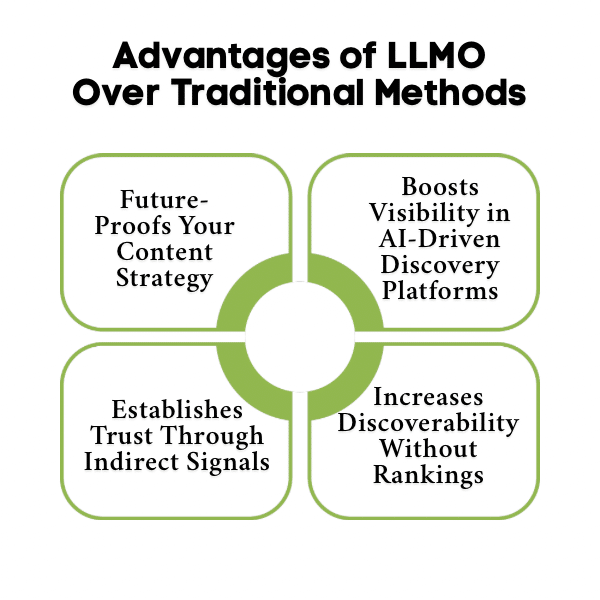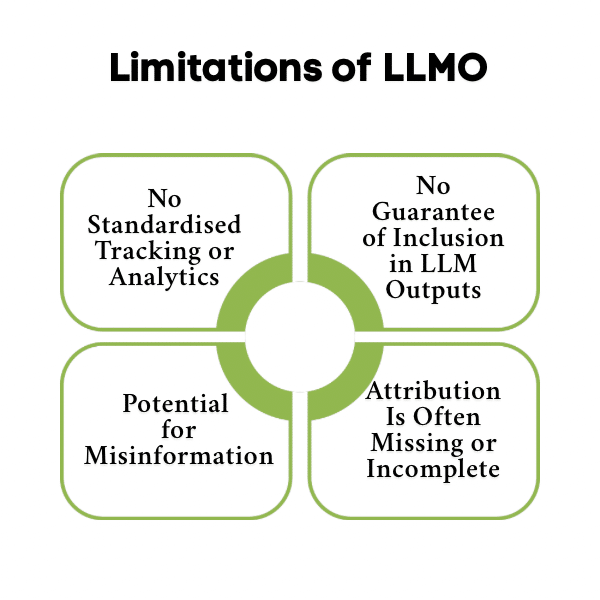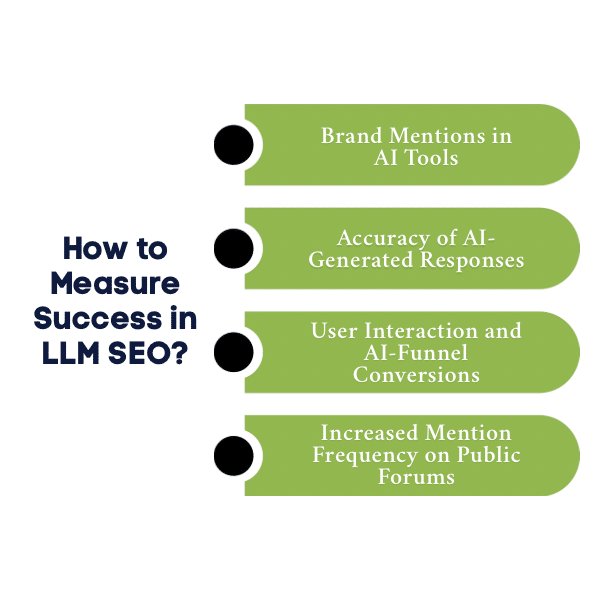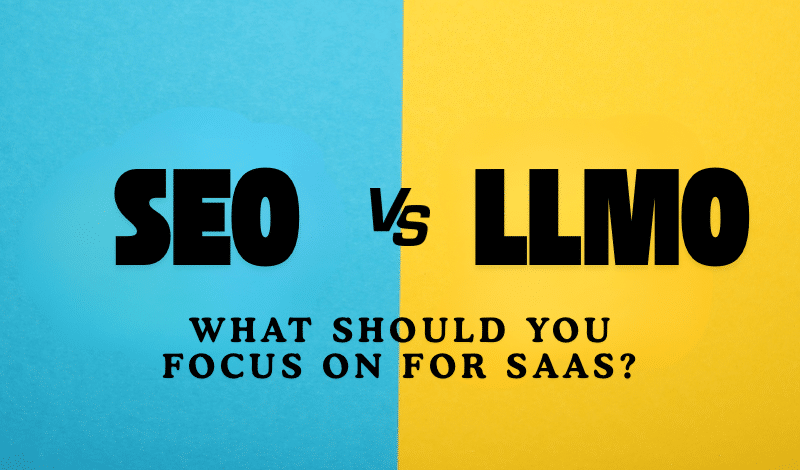TL;DR
- LLMO (Large Language Model Optimization) is essential for visibility in AI search tools like ChatGPT and Perplexity.
- Traditional SEO alone won’t help your content appear in AI-driven direct answers.
- Businesses need to optimise for both search engines and large language models.
- LLMO improves brand presence, organic traffic, and user engagement.
- Now is the time to align your content strategy with this shift.
If you’re still treating SEO as just meta titles and keyword placement, you’re missing half the game. In 2025, search has expanded beyond search engines like Google and Bing. Users are asking questions directly to AI tools powered by large language models, and the answers they’re getting are no longer just blue links; they’re full summaries, recommendations, and lists.
That’s where large language model optimisation (LLMO) comes in. In this blog, we’ll break down what LLMO means, how it differs from traditional SEO, why it matters for modern search, and how you can start optimising your content to appear in AI-generated answers.
What is LLMO?
LLMO, or Large Language Model Optimisation, refers to the practice of making your content, website, or data assets more discoverable and favourable to AI models like ChatGPT, Google Gemini, Claude, and others that generate answers across AI search, chatbots, and embedded applications.
Just as SEO helps you rank better on Google, LLMO ensures that your brand becomes the trusted source AI models pull from when generating responses. But while SEO is about indexing and ranking for search engines, LLMO focuses on aligning with how language models are trained, how they retrieve content, and which sources they trust or cite.
Done right, LLMO can increase your visibility across AI-powered platforms, even when users never visit your website directly.
How to Optimise LLMs for AI Answers? A Practical LLMO Strategy

An Infographic on How to Optimise Your Content for LLMs
Here’s how you can align your content to show up more frequently, and more favourably, in AI-generated answers:
1. Use Clear, Structured Formatting
Make your content easy for AI models to read and understand. Organise pages with meaningful headings (like H1, H2, H3), use bullet points or numbered lists where appropriate, and include clear FAQ sections. Also, apply proper content formatting that signals structure. This helps LLMs break down and retrieve your content more accurately when generating answers.
2. Write for Real, Conversational Queries
Craft your content around how people naturally ask questions in chat or voice search. Instead of using vague phrases like “invoice automation tools,” reframe them as full, intent-driven questions. For example, “What’s the best invoicing tool for freelancers in India?” This aligns your content with the way users interact with AI tools.
3. Contribute to Authoritative Platforms
LLMs prioritise content from highly trusted sources. Try to get your brand mentioned or featured on platforms like Wikipedia, established media houses, government websites, or reputed industry publications. These high-authority signals help build trust and improve your chances of being cited by AI.
4. Highlight Original Insights and Case Studies
AI models favour content that offers depth and originality. Include customer success stories, real use cases, or unique data points from your business experience. The more specific and evidence-backed your content is, the more valuable it becomes for AI-generated responses.
5. Ensure Accuracy and Consistency
AI models rely on up-to-date and reliable information. Review your site regularly to keep facts, dates, pricing, and names accurate and consistent. Inconsistent or outdated information can lead to your content being ignored or deprioritised by language models.
6. Be Visible Across the Web
Your own website is not the only place LLMs look. Maintain consistent brand mentions on third-party platforms such as directories, comparison sites, forums, guest blogs, and news coverage. This broad presence helps reinforce your brand’s credibility in the AI ecosystem.
7. Understand and Align with AI Indexing
Different AI tools index content differently. Learn how platforms like Perplexity or ChatGPT source and surface answers. Make your content easy to crawl by ensuring open access (no unnecessary restrictions), minimal technical barriers, and availability in formats like RSS feeds or machine-readable summaries to aid discoverability.
Curious how AI is already transforming search? Read our blog on how effective Artificial Intelligence is in SEO.
Why Choose LLMO Instead of Traditional SEO Methods?

An Infographic on Advantages of LLMO Over Traditional Methods
While traditional SEO focuses on ranking in search engines like Google, LLMO goes a step further by ensuring your content is discoverable through AI-powered platforms. Here’s how it gives your digital marketing strategy an edge:
1. How Does LLMO Future‑Proof Your Content Strategy?
Search behaviour is changing. As search engine dynamics evolve and more users turn to AI assistants, relying solely on keyword rankings won’t be enough. LLMO helps your content remain relevant and visible even as the search landscape shifts.
Think long-term: what ranks today might be replaced by what answers tomorrow.
2. How Can LLMO Boost Your Visibility on AI‑Driven Platforms?
Platforms like ChatGPT, Perplexity, and Gemini are becoming primary sources of information. By optimising for LLMs, your content is more likely to appear in these generative AI outputs, where users are already looking for direct answers.
3. How Does LLMO Help Build Trust Through Indirect Signals?
Even if your page doesn’t rank #1 in traditional search, AI tools value brand presence, contextual relationships, and mentions from authoritative sources. LLMO helps build those indirect signals of trust that influence AI responses.
4. Can LLMO Increase Discoverability Without Rankings?
LLMO ensures your content can be surfaced in conversations, summaries, or lists, even if it’s not ranking in traditional search engines. This means users can find your insights or solutions without ever clicking on a search result.
You don’t have to win the ranking war to win visibility in the AI era.
Are There Any Limitations or Challenges Associated with LLMO?

An Infographic on Limitations of LLMO
As powerful as LLMO is, it comes with its own set of challenges that marketers and businesses must be aware of before going all in. Here’s what we’ve observed:
1. No Standardised Tracking or Analytics (Yet)
Unlike traditional SEO, where tools like Google Analytics and Search Console offer clear performance metrics, LLMO lacks universal benchmarks. There’s currently no widely accepted tool to track how often your brand is mentioned or cited in AI-generated content.
You may show up in AI answers, but there’s no dashboard to quantify it, yet.
2. No Guarantee of Inclusion in LLM Outputs
Even with the right content, large language models might not reference your brand. These models pull from a wide training set and don’t prioritise recent content or well-optimised pages unless they’re reinforced through multiple authoritative signals like backlinks, citations, or external mentions.
Just because your content is excellent doesn’t mean an LLM will surface it.
3. Potential for Misinformation
AI tools can sometimes generate inaccurate or misleading answers. If your knowledge graph presence is weak or outdated, your brand could be misrepresented, or worse, ignored completely. That’s a big risk, especially in high-stakes industries like healthcare or finance.
4. Attribution Is Often Missing or Incomplete
Even when your content is referenced in an AI answer, it may not be explicitly attributed. This means you might influence a user’s decision without ever earning a visit, link, or measurable engagement.
So, How Should You Approach This?
We don’t see LLMO as a replacement for traditional SEO. Instead, we treat it as a complementary strategy, one that works alongside technical SEO, content strategy, and user intent mapping.
By integrating both, you’re not just optimising for clicks; you’re building visibility in the broader AI discovery ecosystem. And as AI-generated search continues to grow, that’s where your audience will increasingly be.
Curious how AI is reshaping search rankings? Check out our blog on How effective is Artificial Intelligence in SEO?.
How Do You Measure Success in LLM SEO?

An Infographic on How to Measure Success in LLM SEO
Measuring success in traditional SEO often involves tracking traffic, keyword rankings, and conversions using tools like Google Analytics. But when it comes to LLMO, success metrics are less direct, but still measurable with the right focus.
Here are a few meaningful ways to assess how well your content is performing in the world of large language model optimization:
1. Brand Mentions in AI Tools
Regularly check if your brand or product is being cited in tools like ChatGPT, Gemini, and Perplexity. Type in relevant prompts and see whether your business shows up in the response, and how accurately.
2. Accuracy of AI-Generated Responses
Beyond visibility, quality matters. Monitor how LLMs describe your services, offers, or value proposition. Are they aligned with your current positioning? If not, it may indicate outdated training data or unclear messaging on your site.
3. User Interaction and AI-Funnel Conversions
While direct attribution is tricky, a rise in inbound queries that reference “I saw this on ChatGPT” or AI-assisted decision-making signals LLMO is working. Track changes in lead quality, form fills, or demo requests coming from new AI-influenced funnels.
4. Increased Mention Frequency on Public Forums
Monitor discussions on platforms like Reddit or Quora. If your brand is being organically recommended in answers or comparisons, that’s a strong indicator of LLM-influenced visibility, especially if it’s tied to contextual relationships and product relevance.
Discover how ChatGPT can supercharge your SEO on our blog Revolutionize Your SEO With ChatGPT.
How Can LLMO Be Applied in Various Industries?
LLMO is particularly effective in industries where authority, accuracy, and user trust are critical. These sectors often see higher inclusion in AI-generated responses due to their reliance on verified and contextual content.
Here’s how LLMO can support different industries:
- Healthcare: Precision matters. AI tools favour medically accurate, well-structured content that answers patient queries clearly.
Example: A hospital publishes FAQ-rich blogs like “What are the early signs of PCOS?” and uses schema markup, making it more likely for ChatGPT or Perplexity to summarise and cite it.
- Finance: Financial brands benefit when their content focuses on regulations, credibility, and trustworthy fact-checking to reduce misinformation.
Example: A fintech brand explains “How to file income tax returns for freelancers in India,” backed by government links and updated figures. This improves chances of inclusion in LLM-generated financial advice.
- SaaS: LLMO helps SaaS companies stand out through comparison guides, product explainers, and onboarding tutorials tailored to user needs.
Example: A CRM software company publishes a guide on “Best CRMs for remote teams,” using user-centric language, product comparisons, and case studies, ideal for summarised AI responses.
- Education: Educational platforms can improve LLM visibility with content that explains concepts, defines terms, and clarifies learning paths.
Example: An edtech company creates glossary-rich blogs like “What is the difference between machine learning and deep learning?”, increasing its chances of being referenced by LLMs in student queries.
- Local Services: Professionals offering local services gain traction when they optimise for conversational and intent-based questions tied to their region.
Example: A wedding planner in Chennai creates location-specific content like “Top 5 beachside wedding venues in Chennai,” optimised for local keywords and FAQs, making it easier for AI tools to recommend them for regional searches.
SEO vs LLMO for SaaS: What Should You Focus On?

SEO vs LLMO comparison graphic with the text What should you focus on for SaaS displayed on a split blue and yellow background
SaaS companies operate in a highly competitive, fast-moving space, where discoverability, trust, and clarity matter at every stage of the user journey. To stay ahead, you need more than just rankings. You need to be present where your users are getting answers, including from AI-generated responses.
While SEO helps bring traffic through traditional search results, LLMO ensures your product, use cases, and brand name appear in AI tools like ChatGPT and Perplexity when users ask specific SaaS-related queries.
How Can SaaS Brands Optimise for Both SEO and LLMO?
SaaS companies compete in a crowded digital space where both search rankings and AI-driven discovery matter. To stay ahead, your content must align with both SEO and LLMO, optimised not just for Google, but also for language models powering AI tools and answer engines.
Here’s how SaaS brands can effectively optimise for both:
- Optimise FAQs and Help Content: Convert product documentation, onboarding guides, and knowledge base content into clear, answer-ready formats. AI tools love content that directly addresses user questions.
- Use Entity Mentions Strategically: Make sure your brand, product features, industry terms, and benefits are mentioned naturally and consistently. This strengthens contextual relationships that LLMs rely on.
- Leverage Digital PR and Thought Leadership: Publish on reputable sites, contribute to expert roundups, and get cited by authoritative sources. These signals increase the likelihood of being included in LLM responses.
- Monitor Community Signals: Mentions on platforms like Reddit, Quora, and GitHub can influence both AI training data and user trust. Encourage conversations around your product in these channels.
- Target Comparison and Use Case Queries: Optimise for searches like “best HR software for startups” or “alternative to Salesforce for small teams.” These long-tail, intent-driven queries often trigger AI summaries.
SEO vs. LLMO in 2025? Where Are We Headed?
The way people discover content online is undergoing a major shift. While traditional SEO still plays a critical role in driving visibility via search engines like Google and Bing, the rise of generative AI has introduced a new player in the content discovery game: LLMO.
In 2025, we’re not looking at an either-or scenario. Instead, we’re entering a hybrid landscape, where users engage with both traditional search results and AI-generated answers depending on their intent and context.
For example, users still rely on Google to compare prices, read reviews, or explore e-commerce listings. But for quick explanations, definitions, or even product recommendations, they’re increasingly turning to tools like ChatGPT, Gemini, and Perplexity.
According to a recent study by SEMrush, 13.14% of all Google queries triggered AI Overviews in March 2025, up from just 6.49% in January. This spike has sparked a broader question across the industry: Where are we at with LLMs and search engines utilizing this technology? The answer lies in the growing overlap between AI-driven answers and traditional search.
This shift calls for a strategic blend of both SEO and LLMO in your content planning.
So, Are AI Answers Replacing Search Results?
Not entirely, but the landscape is undeniably evolving.
Instead of clicking through ten links on a search engine, users are now asking AI tools direct questions and receiving summary-style answers pulled from a mix of sources. These AI responses are built on language models trained on enormous datasets, often surfacing insights from brands without sending traffic to their websites.
This has several implications:
- Search patterns are changing: More users are engaging with AI-first interfaces than ever before.
- Marketing influence is shifting: Brands cited in AI tools can influence buyer decisions before a user even reaches the site.
- Brand mentions carry weight: Being included in an AI-generated response builds trust, even without a click.
- User experience expectations are rising: Users now expect fast, precise, and context-rich answers, whether from search or AI.
So, while traditional SEO is still essential for organic traffic, LLMO is what helps your content show up in the zero-click, AI-dominated discovery space.
Why Choose Wild Creek Web Studio for LLMO and Future-Ready SEO Solutions?
At Wild Creek Web Studio, we stay ahead of the curve, whether it’s Google’s ever-evolving algorithms or the rise of Large Language Models. Our tailored strategies blend traditional SEO best practices with cutting-edge LLMO techniques to ensure your content is visible, credible, and AI-ready.
From SEO content and digital PR to building topical authority and boosting generative AI traffic, we help future-proof your brand across all major search platforms, and beyond.
Ready to get your brand cited by AI? Let’s talk.
Conclusion
We’re still in the early days of AI-driven content discovery, but it’s clear that the future of SEO includes both traditional search engines and LLMO or search platforms powered by artificial intelligence. To remain competitive, brands must optimise for both, using established pillars of ranking alongside emerging LLMO strategies that cater to how users engage with AI-generated answers.
By focusing on topical authority, structured blog posts, and data from tools like Google’s Natural Language API, you can increase your visibility in AI results. Whether you’re targeting generative AI traffic, improving user interaction data, or strengthening your presence through press releases and social media, the goal is to create content that aligns with how and where users search today. It should also match how large language models (LLMs) interpret and surface information.
Frequently Asked Questions
What are the AI definitions for SEO & LLMO?
SEO refers to improving your website’s visibility on search engines like Google by optimising content, structure, and backlinks. LLMO, or Large Language Model Optimisation, focuses on making your content discoverable and trustworthy for AI models like ChatGPT and Gemini so it gets cited, summarised, or referenced in AI-generated answers.
What is the difference between LLM and SEO?
SEO focuses on improving your website’s visibility on search engines like Google. LLM optimisation, on the other hand, helps your content get discovered and cited by AI models like ChatGPT that power generative answers across search and chat platforms.
Are there any advice on AI SEO & LLMO tools?
To optimise effectively for AI discovery, combine traditional SEO tools with AI-focused platforms. Use Scalenut, SurferSEO, or SEO.ai for content planning, and LLMo metrics or Google’s NLP API to track brand visibility and align with large language model optimisation requirements.
Are there certain industries that benefit more from LLM SEO or LLMO?
Yes, industries like healthcare, finance, SaaS, education, and local services benefit the most. These sectors rely on trust, expertise, and detailed content that aligns well with how language models process and deliver information. Their content is often rich in user intent, which makes it ideal for AI-generated responses.
Can LLMO strategies help overcome low visibility in traditional search?
Yes, a well-executed LLMO strategy can boost visibility even when your pages don’t rank on Google Search. By optimising for generative engine optimization, you increase the chances of being referenced in AI responses. This is especially true when your brand appears in forums like Reddit, has a strong backlink profile, and covers relevant topics that LLMs prioritise.
How often should I update content to stay relevant for LLMs?
To remain visible in AI-generated answers, it’s best to review and update key content at least once every quarter. This ensures your facts, figures, and terminology remain current and aligned with the evolving training data used by large language models.
How does LLMO impact zero-click search behaviour?
LLMO plays a key role in zero-click search by increasing the chances of your content being featured in AI-generated summaries. Even if users don’t visit your website directly, your brand can still influence decisions through accurate, well-structured responses delivered by large language models.
